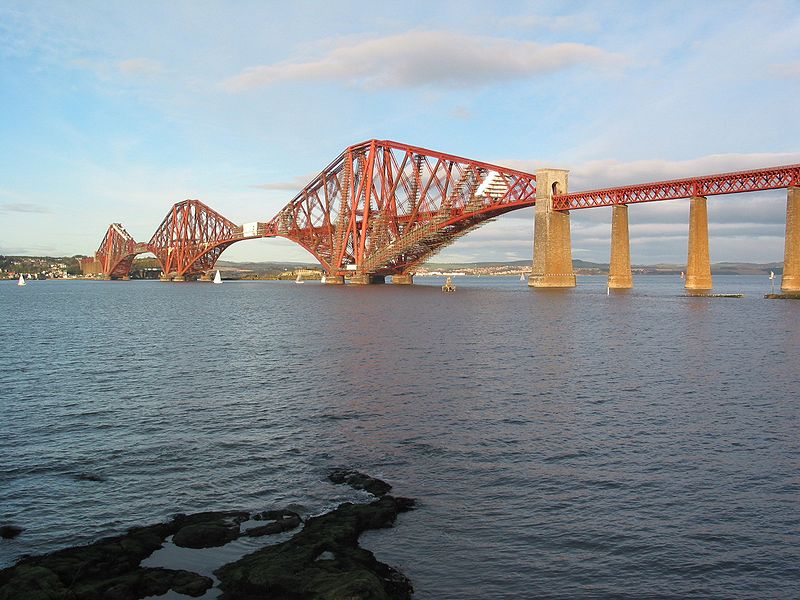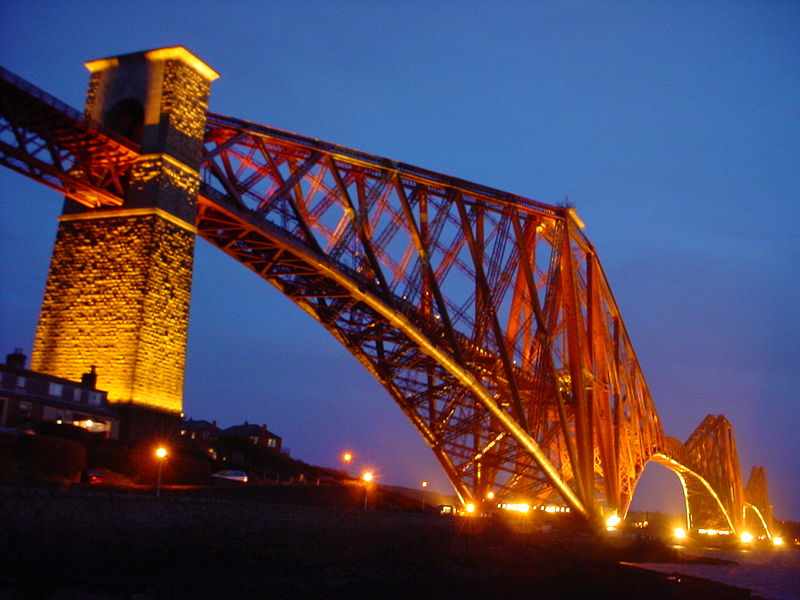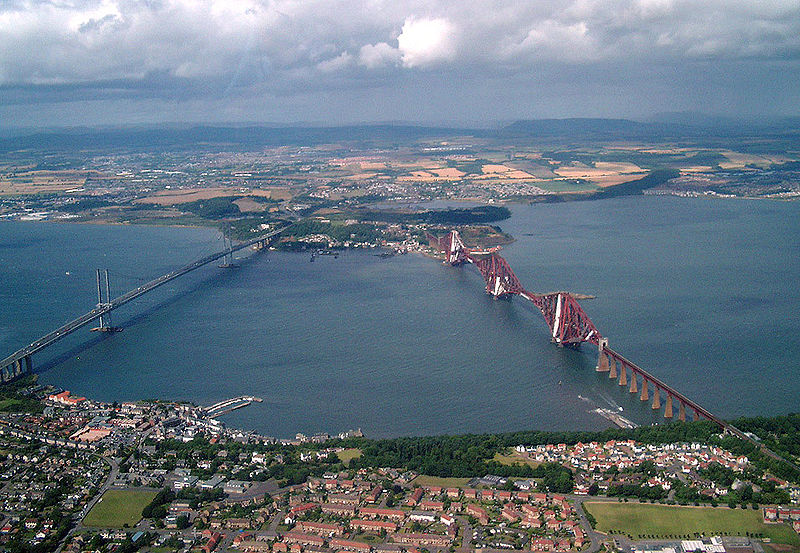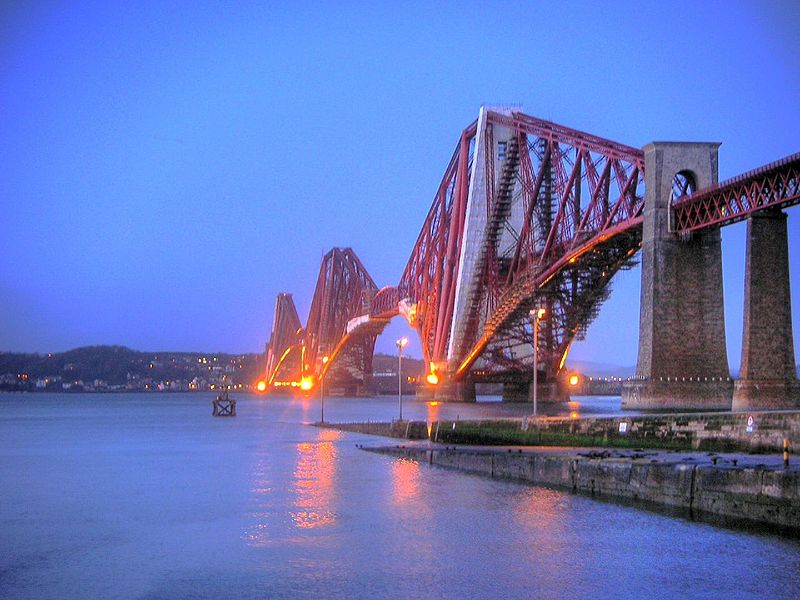Forth Railway Bridge
The Forth Bridge is a cantilever railway bridge over the Firth of Forth in the east of Scotland, to the east of the Forth Road Bridge, and 14 km (9 miles) west of central Edinburgh.

Forth Bridge
Carries Rail traffic
Crosses Firth of Forth
Locale Edinburgh, Inchgarvie and Fife, Scotland
Design Cantilever bridge
Total length 2,528.7 metres (8,296 ft)
Longest span 2 of 521.3 m (1710 ft)
Clearance below 150 feet (46 m)
Opening date March 4, 1890

It is often called the Forth Rail Bridge or Forth Railway Bridge to distinguish it from the Forth Road Bridge, but should correctly be referred to as the Forth Bridge. The bridge connects Scotland's capital Edinburgh with Fife, and acts as a major artery connecting the north-east and south-east of the country. Described as "the one internationally recognised Scottish landmark", it may be nominated by the British government as a UNESCO World Heritage Site. The bridge and its associated railway infrastructure is owned by Network Rail Infrastructure Limited.

History
Construction of an earlier bridge, designed by Sir Thomas Bouch, got as far as the laying of the foundation stone, but was stopped after the failure of another of his works, the Tay Bridge. Bouch had proposed a suspension bridge but the public inquiry into the Tay bridge disaster showed that he had under-designed the structure and mistakenly used cast iron, which weakened the entire structure. Upon Bouch's death the project was handed over to two other Englishmen Sir John Fowler and Sir Benjamin Baker, who designed a structure that was built by Glasgow based company Sir William Arrol & Co. between 1883 and 1890. Baker – "one of the most remarkable civil engineers Britain ever produced" – and his colleague Allan Stewart received the major credit for design and overseeing building work. During its construction, over 450 workers were injured and 98 lost their lives.
Construction
The bridge is, even today, regarded as an engineering marvel. It is 2.5 km (1.5 miles) in length, and the double track is elevated 46 m (approx. 150 ft) above high tide. It consists of two main spans of 1,710 ft (520 m), two side spans of 675 ft, 15 approach spans of 168 ft (51 m), and five of 25 ft (7.6 m). Each main span comprises two 680 ft (210 m) cantilever arms supporting a central 350 ft (110 m) span truss. The three great four-tower cantilever structures are 340 ft (104 m) tall, each 70 ft (21 m) diameter foot resting on a separate foundation. The southern group of foundations had to be constructed as caissons under compressed air, to a depth of 90 ft (27 m). At its peak, approximately 4,600 workers were employed in its construction. Initially, it was recorded that 57 lives were lost; however, after extensive research by local historians, the figure was increased to 98. Eight men were saved by boats positioned in the river under the working areas.

Hundreds more were left crippled by serious accidents, and one log book of accidents and sickness had 26,000 entries. In 2005, a project was set up by the Queensferry History Group to establish a memorial to those workers who died during the bridge's construction. In North Queensferry, a decision was also made to set up memorial benches to commemorate those who died during the construction of both the rail and the road bridges, and to seek support for this project from Fife Council.

More than 55,000 tons of steel were used, as well as 18,122 m³ of granite and over eight million rivets. The bridge was opened on 4 March 1890 by the Prince of Wales, later King Edward VII, who drove home the last rivet, which was gold plated and suitably inscribed. A contemporary materials analysis of the bridge, c. 2002, found that the steel in the bridge is of good quality, with little variation.

The use of a cantilever in bridge design was not a new idea, but the scale of Baker's undertaking was a pioneering effort, later followed in different parts of the world. Much of the work done was without precedent, including calculations for incidence of erection stresses, provisions made for reducing future maintenance costs, calculations for wind pressures made evident by the Tay Bridge disaster, the effect of temperature stresses on the structure, and so on. Where possible, the bridge used natural features such as Inchgarvie, an island, the promontories on either side of the firth at this point, and also the high banks on either side.

The bridge has a speed limit of 50 mph (80 km/h) for passenger trains and 20 mph (32 km/h) for freight trains. The weight limit for any train on the bridge is 1,422 tonnes (1,442,000 kg) although this is waived for the frequent coal trains, provided two such trains do not simultaneously occupy the bridge. The route availability code is RA8, meaning any current UK locomotive can use the bridge, which was designed to accommodate heavier steam locomotives. Up to 190–200 trains per day crossed the bridge in 2006.